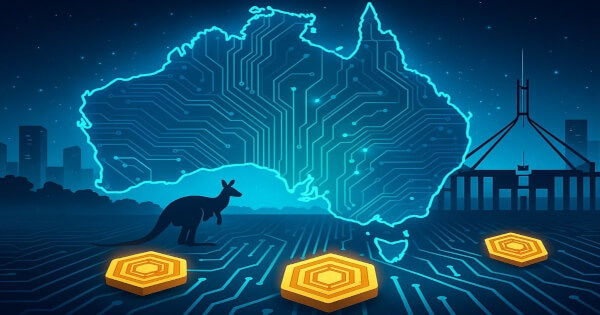Australia's 2025 Digital-Assets Bill: Canberra Tries to Court 'Silicon Valley Down Under'
Khushi 'v Rangdhol Jul 21, 2025 09:08
Australia's upcoming Digital Assets Bill aims to establish a clear licensing framework for crypto platforms by 2026. It could attract investment, but concerns about compliance costs and fragmented regulations persist. The draft will be consulted in August 2025, with a focus on a Digital-Asset Platform Licence (DAPL) and stable-coin rules. If successful, it may position Australia as a hub for digital innovation. Investors are eager for clarity on fees and regulations.

Why This Bill Matters
Treasury’s newest policy note, “Developing an Innovative Australian Digital‑Asset Industry,” confirms Canberra will publish a draft Digital Assets and Markets Regulation Bill before the end of 2025 and put it to Parliament in early 2026. If enacted, Australia would move from piecemeal ASIC guidance to a single licensing rulebook—much like Europe’s MiCA—at a moment when local exchanges warn they may quit the country without clearer ground rules. Coinbase’s Australia head told The Australian in March that the firm could “re‑evaluate” its footprint if licensing remains “burdensome”.
What the Government is Proposing
Although the draft text is still in Treasury’s legal shop, public consultation papers and Senate hearings outline three pillars:
- Digital‑Asset Platform Licence (DAPL)
Any firm holding A$5 million or more in customer crypto—or facilitating trades above that threshold—would need a DAPL, built as a “modular, AFSL‑like authorisation.” Consumer safeguards (segregated custody, conflict‑of‑interest bans, whistle‑blower hotlines) mirror Australia’s traditional financial‑services regime. Stable‑coin issuers over A$150 million float must meet additional capital and attestation rules. - Custody & Safekeeping Requirements
Platforms would have to store at least 80 % of customer assets in cold wallets and publish quarterly proof‑of‑reserves audited to a yet‑to‑be‑finalised ASIC standard. - Stable‑Coin Carve‑Out
Recognising global momentum, Treasury wants to allow AUD‑backed or foreign‑currency stable‑coins if reserves sit in cash or Australian sovereign debt. The Reserve Bank will keep an “oversight window,” but a direct retail CBDC remains off the table for now.
Treasury officials briefed industry groups in May that the draft will “largely absorb” elements of Senator Andrew Bragg’s 2023 private member’s bill, which already passed Senate committee review. But unlike Bragg’s bill, the government text will dovetail with existing AFSL architecture to avoid regulatory duplication.
Where Canberra is Taking Cues
- MiCA (EU) – passportable exchange/custody licences and a stable‑coin tiering model.
- Dubai (VARA) – activity‑based fees instead of fixed minimum capital for smaller start‑ups.
- Hong Kong – mandatory insurance or bank guarantees for custody operations.
Treasury’s March statement explicitly references Europe and Hong Kong as “comparator jurisdictions” for disclosure and reserve rules.
Industry Reaction
Andrew Bragg, Liberal Senator: “Treasury is finally moving, but Labor’s timeline risks another lost year.”
Caroline Bowler, BTC Markets CEO: “An AFSL‑style licence is workable if ASIC keeps the fee tiers reasonable; start‑ups can’t absorb bank‑level compliance costs.”
John O’Loghlen, Coinbase Australia (quoted in March interview): “Complementary legislation is essential; otherwise we’ll keep seeing capital and talent fly to Singapore.”
No major exchange has threatened immediate exit, but both Kraken and Binance have frozen aggressive retail marketing until the draft text clarifies how staking and DeFi yield products will be classified, according to executives who spoke on background. (These statements are not yet in public documents.)
What Success Looks Like
- A “crypto AFSL”: If the DAPL licence proves as portable as the traditional Australian Financial Services Licence, exchanges could offer derivatives, staking and yield products under one roof—something not yet possible under ASIC’s current ad‑hoc no‑action letters.
- A path to AUD‑stable‑coins: Treasury insiders say at least three banks are exploring fully reserved “eAUD” tokens pegged 1:1 to T‑bills; Telstra Ventures is reportedly backing one consortium. (Those conversations are background only; no public filings yet.)
- Regional edge: Singapore’s Payment Services Act is already live; Hong Kong’s VASP rules took effect in 2024. A well‑timed Australian regime could still catch the next investment wave, especially from Southeast Asian projects looking for English‑language legal predictability.
The Next Six Months
- August 2025 – draft bill released for 90‑day consultation; cross‑bench MPs vow to accelerate if a snap election is called.
- October 2025 – ASIC finalises Information Sheet 225 updates, giving preliminary compliance sign‑posts.
- February‑March 2026 – government aims to introduce the final bill; opposition indicates conditional support, suggesting bipartisan passage before FY 2026‑27 Budget.
Bottom line: Canberra’s new bill could turn Australia into a Silicon Valley Down Under—or miss the moment if consultation drags. A clear, affordable DAPL licence plus a stable‑coin rule could keep developers on‑shore and attract global capital. Investors will be watching August’s draft for the fee schedule, custody insurance details and any hint of a staking ban. Until then, local exchanges continue to operate under a patchwork of ASIC guidance and bank de‑risking, hoping Treasury’s promised clarity finally arrives.
Image source: Shutterstock.jpg)
